Cats are renowned for their love of sleep, often dozing for up to 16 hours a day, and sometimes even more as they get older. As a cat owner, you’ve likely witnessed your feline companion in a variety of sleeping positions, some of which might seem quite peculiar.
Have you ever wondered what it means when your cat curls up into a tight ball versus stretches out right beside you? A cat’s sleeping behavior is deeply rooted in their instincts and social nature. Despite their independent reputation, cats are social creatures capable of forming strong bonds with their human families and other pets.
One key aspect of their sleep behavior is seeking warmth. Cats naturally gravitate towards body heat while sleeping, which explains why they often choose to nap on or near you. Many cat owners even utilize self-heating cat beds to provide extra warmth and comfort for their feline friends.
However, not all cat sleeping positions are solely about comfort and warmth. Many are linked to their wild ancestry. Cats are both predators and prey, and this duality influences their behavior, especially when they are in a vulnerable state like sleep. In the wild, or even when outdoors, a cat’s survival depends on their alertness and awareness of their surroundings.
This inherent need for vigilance explains why you might find your cat curled up in a tight ball, for example. This position offers protection and security.
By understanding the nuances of cat sleeping positions, you can gain valuable insights into your cat’s state of mind and how they are feeling. Let’s explore 20 common cat sleeping positions and what they reveal about your beloved feline.
1. The Classic Curl: Curled Up in a Ball
 Cat sleeping curled up in a ball to conserve heat and protect vital organs
Cat sleeping curled up in a ball to conserve heat and protect vital organs
One of the most frequently observed Cat Positions is the curled-up ball, with their nose tucked towards their tail. This position is a masterclass in heat conservation. Cats instinctively seek warmth, and curling into a ball minimizes exposed surface area, helping them retain precious body heat. Beyond warmth, this position is also a protective posture. By curling up, cats shield their vulnerable abdominal organs, surrounding them with less sensitive muscle and bone. It’s a cozy and secure way for your cat to snooze.
2. Belly Up: Sleeping on Their Back
 Cat sleeping on back, exposing belly to show trust and security
Cat sleeping on back, exposing belly to show trust and security
Seeing your cat sleeping on their back, with their belly fully exposed, is a sign of ultimate trust and relaxation. In this vulnerable posture, their front paws might rest on their belly or be stretched out overhead. Cats are hardwired to protect their vital organs, so exposing their abdomen while sleeping signifies they feel exceptionally safe and secure in their environment. This position is a compliment to you, indicating your cat feels completely at ease and unthreatened in your presence.
Despite this display of vulnerability and trust, it’s generally advisable to resist the urge to rub your cat’s exposed belly. Even in this relaxed state, most cats retain their instinct to protect their belly area and might react defensively with a nip, swat, or scratch if touched there.
3. Laid-Back Lounger: Side Sleeping
 Cat sleeping on their side, comfortable yet ready to react
Cat sleeping on their side, comfortable yet ready to react
Similar to sleeping on their back, side sleeping with legs stretched out also indicates your cat is comfortable and relaxed in their surroundings. In this position, their vital organs are somewhat exposed, suggesting a level of trust and security in their environment. Side sleeping is a relaxed posture that still offers a degree of readiness.
Unlike the deep vulnerability of belly-up sleeping, side sleeping allows for a quicker response if needed. While relaxed, a cat in this position can easily spring up and move if they sense danger or need to react quickly. This balance of comfort and readiness makes it a popular choice for a restful yet secure nap.
4. The Loaf: Paws Tucked Under
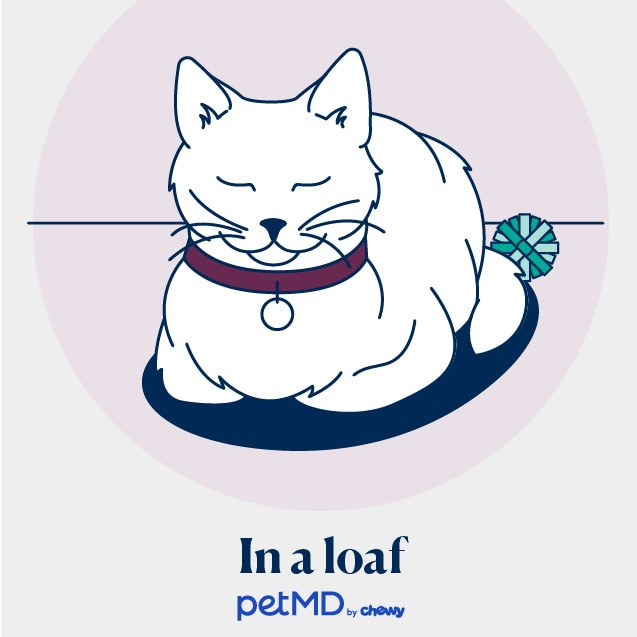 Cat sleeping in a loaf position, relaxed but alert
Cat sleeping in a loaf position, relaxed but alert
The “loaf” position, resembling a loaf of bread, is characterized by a cat tucking their front paws under their body while keeping their head upright. This posture is a blend of relaxation and alertness. Like the curled-up ball, the loaf helps conserve body heat and protect vital organs.
While cats in the loaf position appear relaxed, they are also poised for action. Their tucked paws can quickly extend, and they are ready to spring up or use their claws if they perceive a sudden threat. This position reflects a state of relaxed vigilance, common in domesticated cats who feel relatively safe but retain their instincts.
5. Superman or Sploot: Stretched Out on Their Belly
 Cat sleeping in a superman pose, relaxed and conserving heat
Cat sleeping in a superman pose, relaxed and conserving heat
The “Superman” or “sploot” position is where a cat lies flat on their belly with front legs stretched forward and back legs stretched behind them, mimicking Superman in flight. This extended posture can indicate relaxation, especially if a cat is sprawled out completely.
In the Superman pose, while appearing fully relaxed, cats retain a degree of readiness. All four paws are extended and available for quick movement if needed. This position also offers the benefit of protecting their vulnerable belly against the surface they are lying on.
Sleeping in the Superman position on a warm surface, like a fuzzy blanket, can further aid in heat conservation. Conversely, in warmer weather, cats might choose to sploot on cool surfaces like tile or hardwood floors to help regulate their body temperature.
6. High Perch Snoozing: On Furniture or Appliances
 Cat sleeping perched on furniture, seeking safety and vantage point
Cat sleeping perched on furniture, seeking safety and vantage point
Finding your cat asleep perched precariously on the back of a couch, the arm of a chair, or even atop the refrigerator might seem unsettling, but this elevated sleeping position serves several purposes for a cat.
Firstly, height provides security. From a high vantage point, cats are safer from potential ground-level threats while they sleep. In a domestic setting, these “threats” might be other pets, children, or unfamiliar visitors.
Secondly, as natural predators, a perched sleeping position offers a panoramic view, allowing your cat to keep an eye on their territory and potential prey. While the “prey” in your home is more likely to be cat toys rather than mice, the instinct to observe remains strong.
Providing a cat tree with a high perch can be a great alternative to furniture for cats who prefer to snooze in elevated locations. These dedicated spaces offer a safe and comfortable high vantage point tailored to a cat’s needs.
7. The Contortionist: Strange and Unusual Positions
 Cat sleeping in strange positions, showcasing flexibility and comfort
Cat sleeping in strange positions, showcasing flexibility and comfort
Cats are notorious for sleeping in positions that appear incredibly uncomfortable to humans. However, unlike dogs and humans, cats possess remarkable flexibility. What looks awkward to us is often perfectly comfortable, even relaxing, for a cat.
Their spinal columns are incredibly elastic, allowing them to twist and contort their bodies into seemingly impossible shapes. Additionally, a cat’s shoulder blade is attached to their body primarily by muscle rather than bone, granting them an exceptional range of motion in their shoulder joints. This unique anatomy enables cats to achieve those seemingly bizarre yet comfortable sleeping postures.
8. Sitting Sentinel: Upright Sleeping
 Cat sleeping while sitting up, showing confidence and accessibility
Cat sleeping while sitting up, showing confidence and accessibility
When a cat sleeps in a sitting position, resembling a human sitting upright, it’s often a sign of confidence and security in their environment. In this posture, they are exposing their belly, indicating they feel safe and unthreatened.
Sleeping while sitting up also offers practical benefits for cats. It provides easier access to groom their belly with less effort, allowing for quick cleaning sessions between naps. Additionally, this position may offer support to their back muscles, providing a different kind of comfort.
9. Chest Cuddles: Sleeping on Your Chest
 Cat sleeping on a human chest, seeking closeness and comfort
Cat sleeping on a human chest, seeking closeness and comfort
There are several heartwarming reasons why your cat might choose to sleep on your chest. If your cat is deeply bonded to you, sleeping on your chest is a clear sign they want to be close and connected.
Beyond physical closeness, your cat might be drawn to sleeping on your chest to be near your mouth. Your voice and presence are comforting, and being close to your face can be reassuring for them.
Furthermore, the rhythmic sounds and motions of your body, such as your heartbeat and breathing, can be incredibly soothing to a cat, much like the sound of a heartbeat calms a baby. Finally, your chest provides a wonderful source of warmth, making it an appealing and cozy sleeping spot for your feline companion.
10. Side by Side: Sleeping Next to You
 Cat sleeping next to a human, showing trust with personal space
Cat sleeping next to a human, showing trust with personal space
If your cat sleeps next to you but not directly on you, it doesn’t mean they are less bonded to you. In fact, sleeping near you signifies trust. Your cat is choosing to be in a vulnerable state close to you, indicating a strong level of comfort and reliance.
Some cats prefer a small “buffer zone” even with their beloved humans. Sleeping next to you is their way of expressing their bond and affection while maintaining a sense of personal space, at least in that moment. It’s a sign of closeness with a touch of feline independence.
11. Head Rest: Sleeping on Your Head
 Cat sleeping on a person's head, seeking warmth and soft spot
Cat sleeping on a person's head, seeking warmth and soft spot
Finding your cat nestled on your head while you sleep can be a unique experience. One simple reason for this behavior is the search for a soft and comfortable napping spot. Your head, especially when resting on a pillow, offers a plush and inviting surface.
Another factor is stillness. Your head generally moves less than the rest of your body during sleep, providing a less disturbed and more stable sleeping environment for your cat.
Moreover, cats are creatures of habit and often adapt, loosely, to their human’s sleep schedule. Your cat might simply want to be near you and sleep when you do. Sleeping by your head provides easy access to you when they wake up. From this strategic position, they can readily reach out to wake you for food, attention, or any other needs they might have.
12. Foot Warmer: Sleeping on Your Feet
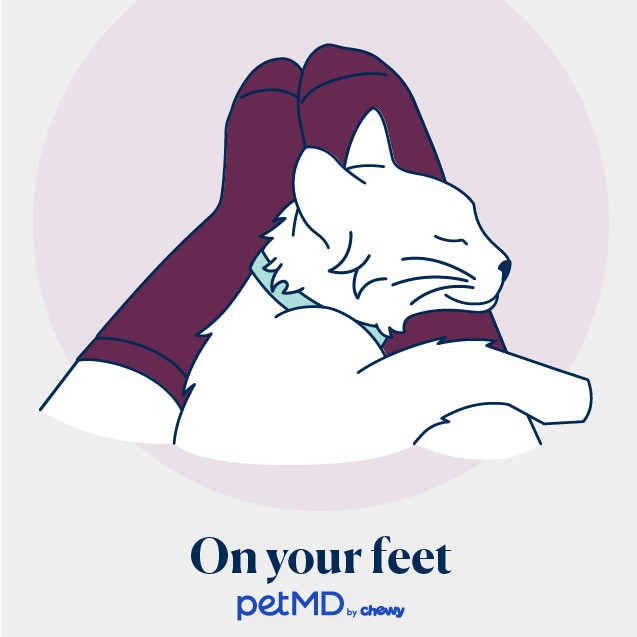 Cat sleeping on a person's feet, providing warmth and security
Cat sleeping on a person's feet, providing warmth and security
When your cat chooses to sleep at your feet, they might be acting as a furry foot warmer, but they are also likely seeking warmth from you. Sleeping by or on your feet allows your cat to be close to you while also offering them a sense of security.
The foot of the bed, couch, or chair provides an easy escape route if needed. This position combines closeness with a perceived safety net, making it a comfortable and secure option for a cat’s nap.
13. Leg Nuzzle: Sleeping Between Your Legs
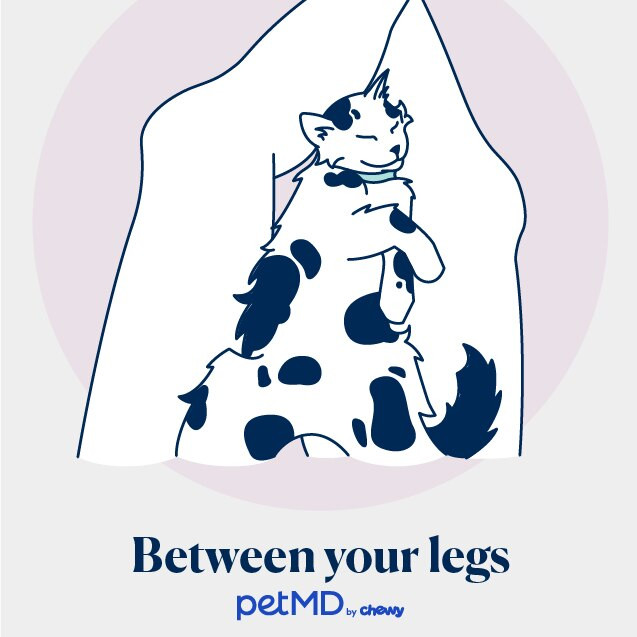 Cat sleeping between a person's legs, creating a secure and warm nest
Cat sleeping between a person's legs, creating a secure and warm nest
Having a cat sleep between your legs might feel a bit confining for you, but it offers several appealing perks for your feline friend. This position allows your cat to be exceptionally close to you, enveloped by the warmth and security of your legs.
Your legs create a natural, nest-like enclosure that feels safe and cozy for a sleeping cat. Despite the close quarters, this position still provides a sense of security because there’s an easy escape route available at either end.
14. Box Bliss: Sleeping in a Box
 Cat sleeping in a box, seeking security and enclosed space
Cat sleeping in a box, seeking security and enclosed space
A cat’s fascination with boxes is well-documented. As prey animals, cats have a deep-seated instinct to seek out enclosed spaces where they can hide from potential threats. This need for security is a primary reason why cats are so drawn to empty cardboard boxes.
Boxes offer a sense of security and warmth, similar to how camping tents provide shelter and safety for humans. They are enclosed yet offer an easy exit if needed, providing a perfect balance of security and accessibility.
When cats attempt to squeeze into boxes that seem too small, they are often seeking that heightened sense of security, reminiscent of the comforting feeling of being swaddled as an infant. The snug fit provides a feeling of safety and containment that cats find inherently comforting.
15. Litter Box Lounging: Sleeping in the Litter Box
 Cat sleeping in a litter box, indicating potential health issue
Cat sleeping in a litter box, indicating potential health issue
If you observe your cat sleeping or even just resting in their litter box, it’s crucial to consider it a potential health concern. Sleeping in the litter box is often a sign of an underlying medical issue, particularly urinary or digestive problems.
If your cat starts sleeping, resting, or even just lying down in their litter box, it’s essential to contact your veterinarian immediately. This behavior can indicate a sudden change in your cat’s health and requires prompt veterinary attention.
While there are rare instances where a cat might simply develop a peculiar habit of sleeping in the litter box, or it might occur in stressful environments like animal shelters where hiding spaces are limited, it’s always best to rule out any medical causes first. Veterinary evaluation is paramount to ensure your cat’s well-being.
16. Open-Eyed Slumber: Sleeping with Eyes Open or Half Open
 Cat sleeping with eyes open, normal but monitor for eye issues
Cat sleeping with eyes open, normal but monitor for eye issues
Cats have the fascinating ability to sleep with their eyes fully or partially open. Sometimes, you might even be able to observe rapid eye movement (REM) sleep in a cat with slightly open eyes, the sleep stage associated with dreaming in humans and likely in cats too.
Cats possess a translucent third eyelid, located beneath their other eyelids, which can be visible when they are sleeping. This third eyelid acts as a protective barrier, preventing irritants and dryness while they nap.
While sleeping with eyes open can be normal for some cats, it’s important to be vigilant and ensure there isn’t an underlying medical reason. If you notice any signs of eye problems, such as eye swelling or discharge, squinting, pawing at the eye, or if the third eyelid is visible while your cat is awake, consult your veterinarian promptly to rule out any eye issues.
17. Paw Sleep Mask: Paws Over Eyes
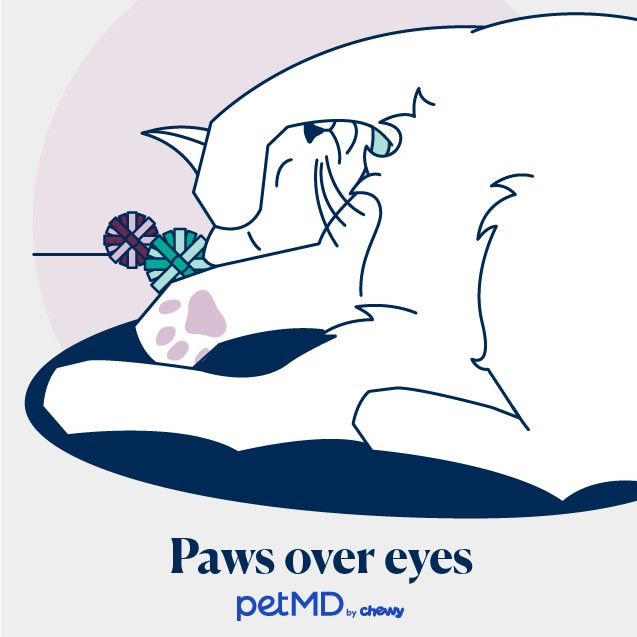 Cat sleeping with paws over eyes, blocking light and providing warmth
Cat sleeping with paws over eyes, blocking light and providing warmth
Seeing your cat sleeping with their paws adorably covering their eyes is undeniably cute, but this behavior serves a practical purpose.
Covering their eyes with their paws can provide insulation and warmth for both their paws and face, especially in cooler environments. Additionally, their paws act like a natural sleeping mask, effectively blocking out bright light or even irritants like dust or pollen, ensuring a more comfortable and undisturbed sleep.
18. Buddy Snoozing: Sleeping with Other Cats
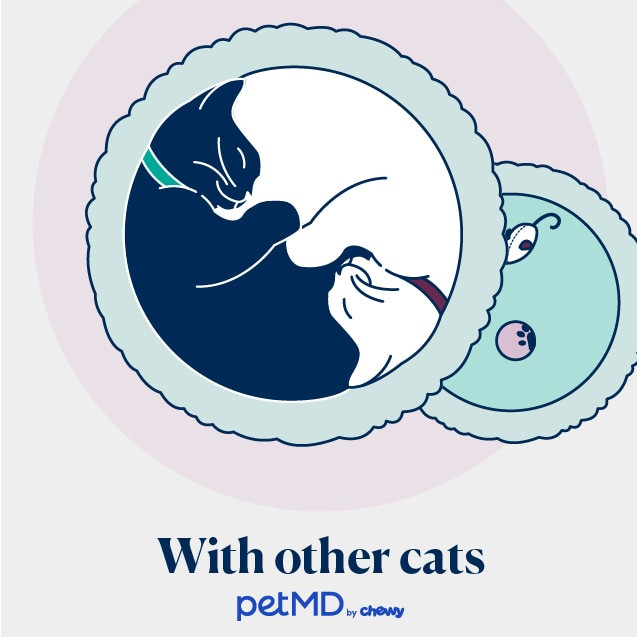 Two cats sleeping together in a cat bed, showing bonding and seeking warmth
Two cats sleeping together in a cat bed, showing bonding and seeking warmth
While some cats in multi-cat households might merely tolerate each other’s presence, many cats genuinely enjoy the company of their feline housemates and will choose to sleep together.
Sometimes, this simply involves sharing a comfortable bed or sleeping spot. However, cats also sleep together because they are bonded to each other, and cuddling up in a group provides shared warmth and security. Cats sleeping in close proximity might also be soothed by the gentle sound of another cat’s purr, further enhancing their relaxation and sense of well-being.
19. Canine Comfort: Sleeping with a Dog
 Cat sleeping next to a dog, showing interspecies bond and comfort
Cat sleeping next to a dog, showing interspecies bond and comfort
Despite the common misconception of cats and dogs being natural enemies, their relationship is more complex. While some cats and dogs may have a predator-prey dynamic, with careful and gradual introductions, many can coexist peacefully, and even form strong bonds.
In instances where cats and dogs develop a positive relationship, they may choose to sleep together for companionship, warmth, and mutual comfort. Just like with human or feline companions, sleeping alongside a dog can provide a sense of security and well-being for a cat, blurring the lines of species and highlighting the power of companionship.
20. Tucked-In Tight: Sleeping Under Covers
 Cat sleeping tucked under a blanket, enjoying warmth and security
Cat sleeping tucked under a blanket, enjoying warmth and security
If your cat enjoys burrowing under blankets or covers, they are likely relishing the warmth and the comforting, familiar scent of their surroundings. The enclosed space under the covers provides a sense of security and coziness.
Cats are also sensitive to noise, and being under covers can offer a welcome escape from stressful or loud sounds, creating a more peaceful sleep environment. Furthermore, some cats simply enjoy the sensation of being wrapped or swaddled in a blanket, finding it inherently comforting and secure.
While it’s generally considered safe for cats to sleep under covers, it’s essential to be mindful of their location to avoid accidentally sitting or stepping on them. Always ensure the material they are under is breathable to prevent any potential breathing issues.
